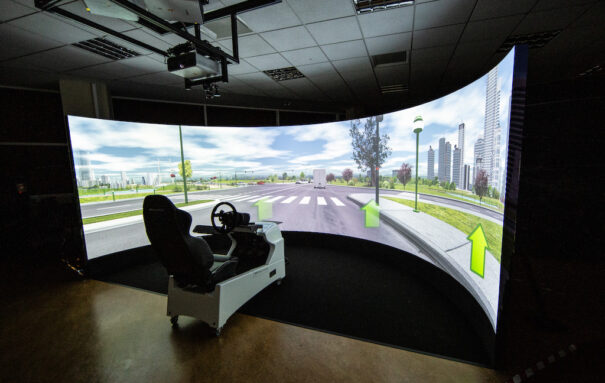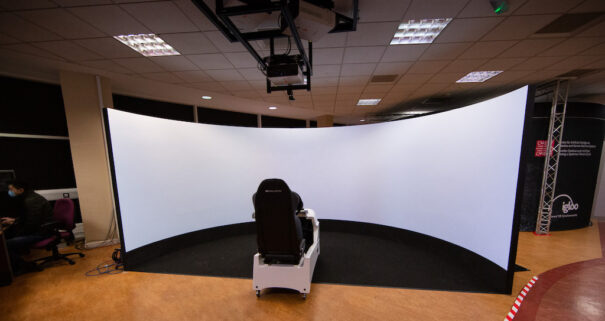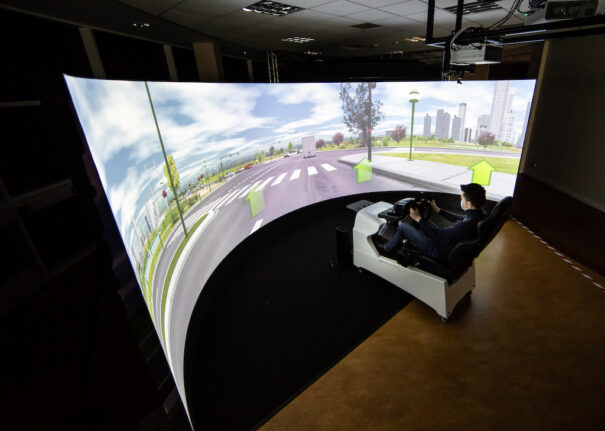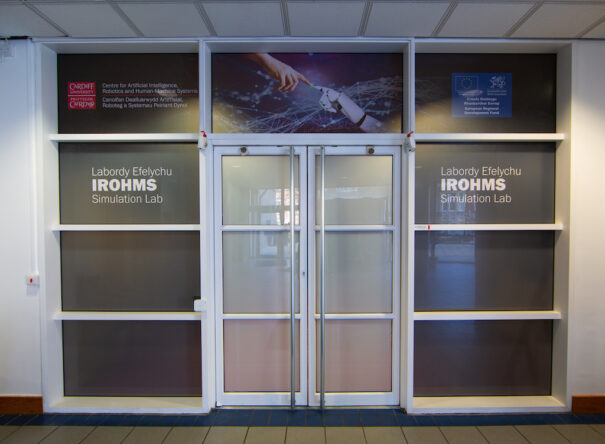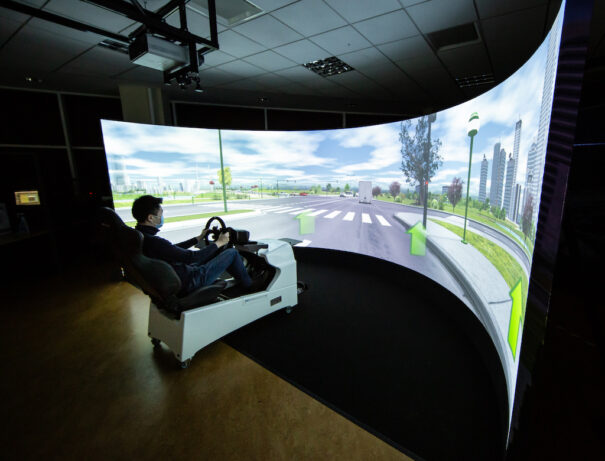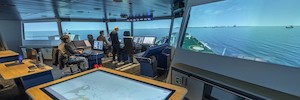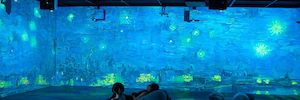Vioso calibra el avanzado simulador de ST Engineering Antycip para vehículos autónomos
ST Engineering Antycip ha contribuido con un simulador diseñado a medida, que utiliza proyectores Canon y el software de calibración de Vioso, a la investigación de las interacciones humanas con vehículos autónomos en la Universidad de Cardiff (United Kingdom).
Esta investigación pionera sobre conducción autónoma, que se realiza en la unidad Prifysgol Caerdydd de la Universidad de Cardiff, cuenta con la tecnología de ST Engineering Antycip para crear un simulador de transporte a medida, compuesto por tres proyectores de Canon calibrados con el software Anyblend VR&SIM of Vioso para lograr una pantalla inmersiva.
Este nuevo simulador permite llevar a cabo un análisis en profundidad y una experimentación precisa centrada en el ser humano, cuyo fin es investigar cómo percibe e interactúa con los vehículos autónomos. La investigación está impulsada por un organismo financiado por la EU, denominado Centro de inteligencia artificial, robótica y sistemas hombre-máquina (Irohms) de esta universidad, supervisado por Phil Morgan, profesor y director de investigación de este centro.
“Una de las cosas que nos interesan es cómo la gente atribuye la culpa en un accidente entre las personas y los coches de conducción autónoma -explica Morgan-. Para estudiar esto desde una perspectiva práctica, es crucial realizar experimentos con simulaciones y, cuando sea posible, con prototipos AV, junto con encuestas y similares, para recopilar datos complementarios sobre las percepciones subjetivas”.
Esto significa medir, tanto cognitiva como emocionalmente, cómo se comportan los seres humanos en relación con el transporte autónomo, en particular durante las situaciones en las que se puede atribuir la culpa.
That is why, añade Morgan, “tenemos que simular algunas situaciones que la gente aún no puede encontrar en el mundo real y evaluar una tecnología que no está totalmente desarrollada, todo en un entorno seguro. Que sepamos, no hay ningún otro simulador de conducción con estas capacidades en Gales y queremos enlazarlo con los pocos que existen en Reino Unido, como el centro de investigación Bristol Robotics Laboratory”.
Qiyuan Zhang, profesor de comportamiento humano de la Universidad de Cardiff, recuerda el inicio del proyecto: “nos habían hablado muy bien de ST Engineering Antycip, así como del proveedor del software de simulación. Destacaban entre sus competidores en el mercado por su larga trayectoria de buenos servicios y su alto nivel de profesionalidad. Aunque el proceso duró más de un año, mereció la pena, ya que sabíamos que el producto final sería apto para el propósito”.
For its part, John Mould, director de desarrollo comercial de ST Engineering Antycip, subraya la larga trayectoria de la compañía en el suministro de soluciones de visualización inmersiva. “La universidad necesitaba un sistema que funcionara en el espacio específico de su sala y acomodar un futuro vehículo de tamaño real o un equipo de simulación de conducción, por lo que utilizamos nuestra experiencia para entender y cumplir sus requisitos y aportamos la solución perfecta en consecuencia”.
Specifically, ST Engineering Antycip proporcionó tres de los proyectores Canon XEED 500ST, cada uno con una luminosidad de 5.000 Lumens, resolución WUXGA y lentes de 0,56:1, que se utilizaron para mapear la superficie de la pantalla. Para ello se montaron desde el techo mediante un soporte mecánico personalizado.
Las señales de vídeo se transmiten desde los generadores de imagen a través de cables HDMI de 15 metre, mientras que se utiliza Ethernet para las comunicaciones de cada proyector y tener un control remoto total.
Mientras que estos componentes eran relativamente comunes, la pantalla se hizo totalmente a medida. “Queríamos un sustrato de pantalla que fuera intrínsecamente más estable que un sistema de tela tensada estándar, para reducir los efectos térmicos y de presión del aire dentro del espacio de la sala con el paso del tiempo”, puntualiza John Mould.
That is why, el equipo de ST Engineering Antycip propuso un “enfoque más artesanal para la pantalla, con una estructura rígida que ofreciera una buena estabilidad para las imágenes que se plasmarían en su superficie. Nuestros socios tecnológicos y el fabricante Visual Displays fueron contratados para apoyar esta instalación, trabajando estrechamente con nuestros ingenieros para crear la superficie de la pantalla cilíndrica a medida”.
El personal de la Universidad de Cardiff recibió formación sobre el funcionamiento de la tecnología por parte de ST Engineering Antycip durante las fases de inicio, pruebas y entrega. In addition, “pueden solicitar nuestro apoyo ad-hoc para ayudarles si encuentran dificultades imprevistas con el sistema en el futuro”, asegura Mould.
Aunque las restricciones de Covid han hecho que el equipo de Irohms tenga que llevar a cabo su investigación en línea por el momento, están deseando tener la oportunidad de poner en marcha el nuevo simulador para esta investigación.
“El desarrollo de esta tecnología debe basarse en el conocimiento -afirma Zhang-, para saber cómo responderán los humanos y asegurarnos de que el diseño de las interfaces hombre-máquina se adapten a la limitada capacidad cognitiva de los humanos. La mera funcionalidad de un sistema es inútil si los humanos no pueden utilizarlo. La mejor manera de hacerlo es mediante la simulación, y estamos muy contentos de que pronto lo haremos”.
You liked this article?
Subscribe to our Feed And you won't miss a thing.



